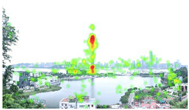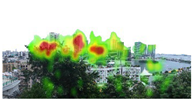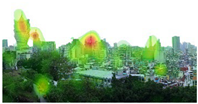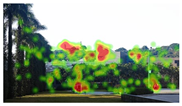Abstract
This study focuses on the visual attention of residents and tourists to elements of urban landscapes from above. It screens out elements that attract viewers’ attention, assesses their aesthetics, and explores how these aesthetic evaluations affect the psychology of place identity. We tracked data from 30 participants, collected responses from 237 participants, and observed differences in visual behaviors and emotional connections to place identity. The results show that while residents and tourists exhibit similar visual behaviors when viewing the same landscape, they have large differences in their perceptual behaviors for different visual elements and have very different familiarity levels in the place identity dimension. Landmark buildings attract strong visual attention despite their low proportion in the overall landscape. Aesthetic factors such as the color vividness of elements like water, mountains, and landmark buildings significantly affect place identity. This study shows that combining eye-tracking and psychometric analysis can effectively evaluate urban landscape perception and provide valuable insights for visual planning and preservation efforts in historic neighborhoods.
1. Introduction
With the rapid growth of global urbanization, urban population density is increasing dramatically. Landscape views in historic districts are blocked by modern tall buildings, and in the face of declining visual environment quality caused by uncontrolled rapid urban development for urban heritage protection, UNESCO has proposed the theory and methods of urban historical landscape [1]. The “Macao Special Administrative Region Urban Master Plan (2020–2040)” also mentions protecting world heritage as an important goal. In urban planning and design, the sustainable development of the overall urban landscape must be considered [2]. However, perception evaluations of important landscape views remain an urgent problem in the coordinated development and protection of historic cities. Constructing a visual environment aesthetic evaluation system with perception as the core has become a major research topic in the field of urban historical heritage protection and planning in recent years [3]. The use and satisfaction of urban landscape architecture physical spaces mediate the psychological health of the public [4]. Constructing an aesthetic evaluation system of the visual environment with perception as the core has become the core research issue in the fields of urban architecture, landscape architecture, and planning in recent years [5]. Visual perception accounts for approximately 80% of all types of human perception, and the visual system is the most accurate way to obtain external information [6]. The evaluation results of a study on urban streets and buildings provide a corresponding basis for the visual control of urban landscape architecture [7]. In a changing urban landscape, we need to understand which architectural elements can attract viewers’ attention from viewing platforms and the psychological impact of their aesthetic evaluation of these visual elements on place identity.
This study focuses on how modern high-rise buildings and key visual elements in urban landscapes affect the beauty and local identity of historical blocks; what methods can be used to construct a visual environmental aesthetic evaluation system based on perception; and how urban landscapes affect the public’s mental health. We aim to construct a visual environment aesthetic evaluation system centered on perception to meet the challenges brought about by the uncontrolled urban development of historical blocks and evaluate the impact of modern high-rise buildings on their landscapes. This study explores the effectiveness of urban landscape perception assessment through eye-tracking and psychometric analysis; provides valuable insights for visual planning and protection in historic districts; and fills a research gap in assessments of spatial perception elements of historic urban areas based on place identity emotions.
2. Literature Review
With advancements in ergonomic technology, eye-tracking experiments have emerged as a scientific approach for exploring human emotions through physiological indicators [8]. These experiments play a crucial role in uncovering the characteristics and patterns of visual behavior when people perceive visual elements in public landscapes [9]. In urban park landscape architecture research, fixed time and counting of eye-tracking experimental data have shown that the proportion of architectural elements affects the evaluation of the space [10]. In terms of mountain landscape architecture, artificial visual elements attract more attention than natural elements [11]. In the field of forest research, the visual behavior of the public toward the surrounding elements is different due to the variable spatial elements of forest landscape architecture [12]. In the field of urban public landscapes, eye-tracking technology is combined with online surveys to analyze the correlation between the proportion of different landscape elements and the public’s visual attractiveness evaluations [10]. In the field of architecture, this provides a new method for understanding architectural space perception and architectural space interaction. One study used VR eye-tracking technology to deeply analyze the visual perception behavior of subjects in the historical city of Zhangzhou, revealing differences in the perception of the urban atmosphere between individuals from different backgrounds [13]. In the field of street architecture, eye movement experiments demonstrated the visual interaction between pedestrians and buildings on both sides of the street, emphasizing the importance of the visual appeal and social function of street architecture [14].
In summary, most scholars focus on visual perceptions and behavioral preferences in relation to landscape architecture, such as forests, mountains, and urban parks. However, the number of previous studies on the relationship between the perception of physical visual elements in the environment and place identity is very limited [15]. The mechanism by which the objective environment that generates visual perception evaluation affects the viewer’s place identity is still unclear. Most research on the public’s perceptions of urban landscape architecture focuses on comparing natural and artificial visual elements, ignoring the differences in evaluation objects. In this study, based on the viewers’ length of stay and purpose while in historic districts, the public is divided into two main groups: residents and tourists. We explore differences in the visual behavior of different populations toward important landscapes in the same historic district. Therefore, the following hypothesis is proposed:
Hypothesis H1.
The public’s perceptions of different visual elements of the same landscape are significantly different.
Topophilia is the emotional connection between people and the natural environment in which they live [16]. In the 1980s, environmental psychology introduced the concept of “place identity”—the “socialized self in the objective world”. The theory of place identity has been empirically studied in relation to urban living and tourist spaces; in terms of theoretical dimension, studies have confirmed the correlation between place identity and familiarity, sense of belonging, environmental preferences, intimacy, cultural atmosphere, the stimulation of former memories, etc. Rather than existing on the same temporal plane, identification processes drive other affective and conative elements that underlie people’s attachments to physical environments [17]. People’s aesthetic evaluations of the visual environment are important links between them and the environment. Most of the research on place identity and emotion around the environment uses the interview method to evaluate emotional tendencies when people visit environments [18]. In a crowd looking at urban landscape architecture, residents and tourists engage in social interactions, and their perceptions of the architecture and its culture significantly impact their urban place identity [19].
Since the 1980s, the evaluation of visual quality has mainly focused on aesthetic evaluations of visual perception. The evaluation object has changed from a single nature evaluation system to a pluralistic human–nature emotional relationship evaluation system. In recent years, street view images have been used to evaluate visual quality through research methods such as machine learning and deep learning [20], and the experimental approach has been used to assess the specific role of the city’s visual and auditory environment in influencing human emotions [21]. However, the impact mechanism between visual aesthetic evaluation and place identity is still unclear. We explore the differences and impact effects between the aesthetic evaluation and place identity of different populations toward important landscapes in the same historic district. Therefore, the following hypotheses are proposed (Figure 1):
Hypothesis H2.
There are differences in the place identity emotions of residents and tourists toward important landscapes in the same historic district.
Hypothesis H3.
There is a significant impact relationship between the perception evaluation of landscape views in historic districts and place identity emotions.
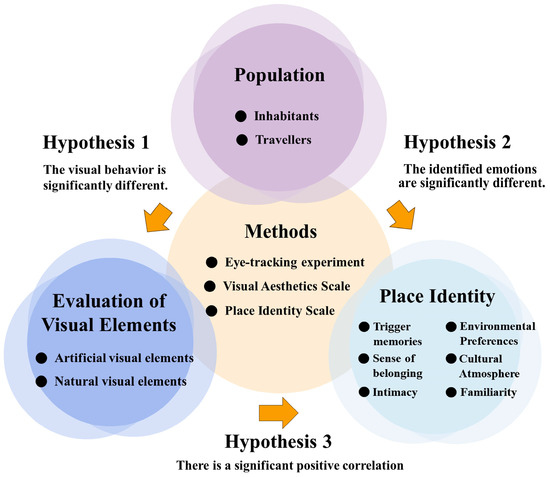
Figure 1.
Conceptual framework of the viewer, visual element evaluation, and place identity.
3. Method
3.1. Study Scope and Stimulus Images
Located on the southeastern coast of China, Macao has the highest population density in the world [22] and an urban history of more than 400 years. The Historic Centre of Macau and its buffer zone are located in the city’s core, accounting for 12.9% of the area of the Macau Peninsula. The city’s urban form has a unique and super-compact style, especially in the Historic Centre [23].
This study aims to define the landscape views of the city based on the overall urban planning of the Macau Special Administrative Region [24]. Viewing points were selected using planning vision—public vision in on-site research—and corridor distribution. Based on observation object categories, the study is divided into 4 themes, with 12 important landscape views (Table 1).

Table 1.
Viewpoints and main visual elements viewed from observation decks in Macao.
We categorized the main visual environmental elements seen from each observation deck. Buildings were classified based on height according to the latest version of China’s Unified Standard for Civil Building Design [25]. Buildings with heights not exceeding 27 m are low-rise buildings; those ranging from 27 to 100 m are high-rise buildings; and those taller than 100 m are super high-rise buildings. The landscape architecture views were classified based on the viewing targets, and the key environmental visual elements were summarized (Figure 2).
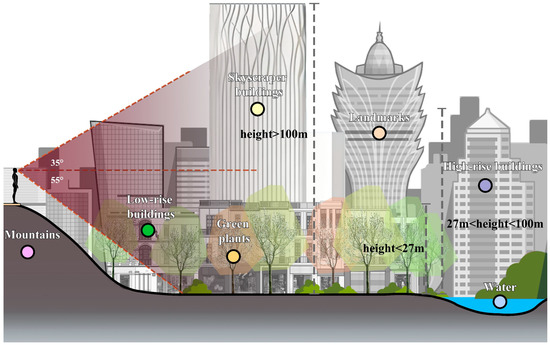
Figure 2.
Schematic diagram of the division of sight lines in the landscape’s architecture.
Landscape photographs are often used for eye-tracking experiments and can effectively replace visual perceptions of the real environment. Moreover, the use of photographs as stimuli for eye-tracking experiments can eliminate the influence of any external conditions, such as light intensity and seasonal changes [26]. Therefore, experimental images were taken in similar weather conditions using a Canon RP camera with a 16 mm lens; the height of the photographer’s eyes was approximately 1.4 m. A total of 168 horizontal landscape architecture images were taken from observation decks in Macao, and five experts were invited to classify them. The experts selected certain images that were then encoded.
The specific practices are as follows: (1) image feature annotation: preliminary observation of 168 images, extraction of keywords of landscape elements (e.g., landmarks, vegetation, water bodies, etc.), and labeling of core features of each image. (2) Free classification: experts group images with similar features according to core landscape features. (3) Integration of grouping: the 168 images were preliminarily categorized into 40 groups by combining obviously overlapping or duplicated categories. (4) Logical correction: cross-category images were adjusted to determine the leader–follower relationship through expert team discussion, including government-defined viewpoints of the landscape, selecting 3–4 images for each viewpoint, retaining 45 landscape images by reducing them to 12 groups. (5) Representativeness verification: This ensured that the most representative image was retained for each group. In total, 12 landscape images of core viewpoints in the Historic Centre of Macao were selected, forming a structured image library that could support the oculomotor experimental study. Finally, the selected images were used for material selection and coding.
The images were normalized with a 16:9 aspect ratio, and the resolution was 6000 × 3374 dpi. As weather is an uncontrollable factor in the environment, a study of the perception of visual sky elements was outside the scope of this research, so the sky in the images was uniformly replaced with white areas (Figure 3).
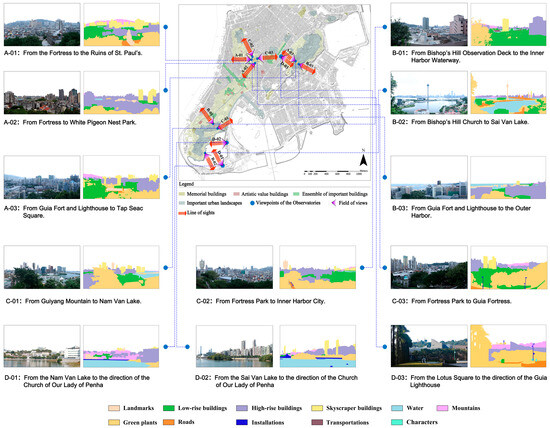
Figure 3.
Distribution of important sightlines in the Historic District of Macao and AOI images.
3.2. Eye-Tracking Experiments
3.2.1. Experimental Participants
During the study, 30 members of the public who had visited observation decks in Macao were selected and divided into two groups, residents (n = 15) and tourists (n = 15), according to their purpose in visiting and the length of their stay. Two eye-tracking experiments were conducted at the lab. The participants were exposed to the relevant image samples for the first time; had good visual acuity, with naked eye or corrected visual acuity of 1.0 and above; and had no color weakness or color blindness. They were between 20 and 40 years old and had diverse professional backgrounds, with 12 participants from architecture-related majors and 18 from non-architecture-related majors, covering fields such as industrial design, physics, chemistry, computer science, and fine arts. In the viewing scene section, we allowed participants to view the scene freely, as free viewing is the most natural and common way to view landscape architecture, maximizing the simulation of daily viewing conditions [27].
3.2.2. Experimental Protocol
Considering the interference effect of light on eye-tracking experiments, the testing was conducted in a laboratory. Curtains were used throughout the experiment to block out outdoor light sources, and the laboratory light environment was adjusted and controlled through internal lighting. The eye-tracking experiments were conducted with Tobii Pro Fusion, manufactured by a Swiss company, and images of the experimental material were displayed on a 23.8-inch screen (1920 × 1080 dpi, 600 Hz) in the lab.
To begin, participants were placed in a laboratory with a capacity of more than 40 people, and the experimenter explained the purpose, procedures, and requirements to the participants individually before the start of each eye movement experiment, with no conversation between participants. Once participants understood the experiment, they were invited to sit in a comfortable chair and were assisted by the experimenter in calibrating the eye tracker to make sure that it was calibrated accurately. Then, nine sample images of the study site were displayed. Each image sample was displayed for 20 s with a two-second gap between images; this was intended to alleviate eyestrain and ensure visual focus adjustment.
Each session lasted approximately 30 min, with approximately 4 min of introduction and preparation before the experiment, approximately 6 min for the eye-tracking experiment, and approximately 20 min for the questionnaire content (Figure 4).
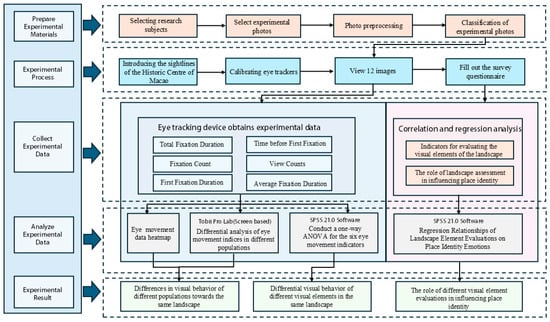
Figure 4.
Step-by-step diagram of the eye-tracking experiment.
3.2.3. Drawing AOIs
The relationship between visual behavior and the visual environment was explored using areas of interest (AOIs). The AOIs in the samples were determined according to the main fixed elements of the images to analyze the spatial and visual elements of the samples. The visual elements in the environment around the observation decks in Macao were divided into features such as landmarks, low-rise buildings, high-rise buildings, skyscraper buildings, green plants, water, mountains, roads, and so on.
3.2.4. Data Index Selection
To explore the visual behavior characteristics of the residents and tourists in relation to AOIs in the images, several eye-tracking indicators were analyzed. Six were selected—total fixation time (TFD), fixation count (FC), time before first fixation (TFF), time to first fixation (FFD), average fixation duration (AFD), and view count (VC) [28] (Table 2). These metrics were used to identify the characteristics of viewer visual behavior toward visual elements of the urban overlook landscape.

Table 2.
Eye-tracking indexes for different landscape elements.
3.3. Visual Aesthetics and Place Identity Scale
3.3.1. Questionnaire Design
After the experiment and the retrospective interviews, the same A1–D3, 12 landscape pictures from the eye-tracking experiment were used to evaluate the aesthetics of the different visual elements. The color labels of the visual elements were divided by the AOIs; combined with the dimension of place identity, the degree of identification of the tourists and residents was psychologically measured. The questionnaire took the residents and tourists as the subjects and preliminarily screened the visual elements according to the distribution of eye movement. Moreover, we invited six experts in the field of architecture to classify and describe the visual elements of the overlooked landscapes. We selected eight evaluation indicators—the proportion of coordination, form richness, neatness and aesthetics, color vividness, change difference, and so on—to evaluate the visual aesthetics of the landscape architecture viewed from urban observation decks. This was combined with the five-point Psychological Scale of Place Identity Likert scale (Table 3), which was completed by the residents and tourists [29].

Table 3.
Visual aesthetic and place identity evaluation scale.
3.3.2. Questionnaire Participants
A total of 250 participants were selected at observation decks in Macao, including 30 participants from the eye-tracking experiment. In total, 250 questionnaires were distributed, 225 of which were online. The questionnaire was collected from 1 November 2023 to 30 December 2023. A total of 237 valid questionnaires were collected, with a response rate of 94.8%.
3.3.3. Data Analysis
The data were analyzed using SPSS 21.0 (IBM Corp., Armonk, NY, USA) and plotted using Origin 2022 (OriginLab Corp., Northampton, MA, USA) and Adobe Photoshop CS6 (Adobe Inc., San Jose, CA, USA). The procedure was as follows.
- (1)
- One-way analysis of variance (ANOVA) was used to analyze the differences in visual behavior indicators and to determine the differences between groups of people at the same viewing platform for the same image and different visual element eye movement indicators. An independent sample t-test and univariate analysis were performed, and H1 was verified.
- (2)
- A visual aesthetic evaluation and psychometric measurement of different scenes were carried out using the questionnaire data. Reliability and validity analyses and an independent sample t-test were carried out to determine the psychological differences between different groups of people in relation to places with the same overall landscape architecture. The aim was to verify H2.
- (3)
- Correlation analysis and multiple regression equations were used to determine the correlation between the aesthetic evaluation indexes of different visual elements and place identity, and H3 was verified.
4. Results and Analysis
4.1. Eye-Tracking Heat Map Distribution and Analysis
The eye-tracking data collected using Tobii Pro Lab (v1.194) were processed for analysis to create an eye movement heat map of the images. Moreover, through notation, the most crucial visual elements, as perceived by both residents and tourists, were analyzed and filtered out. Taking the thermal distribution in Figure A-01 as an illustration, visual elements such as landmark buildings, high-rise buildings, super high-rise buildings, and water systems within the figure draw a high level of attention. These elements are represented by dark red and orange-red colors and the “●” symbol. Lower buildings and mountains are also considered, but their prominence is less evident. They are depicted with light green spots and the “◎” symbol. Green plants and roads attract relatively little attention. There is no heat distribution for them, and no light green spots are present, with the “○” symbol being used. As for Figure A-02′s heat distribution, there are no visual elements of landmark buildings in the figure, and the “×” symbol is used. The identification situation for the other heat maps is the same, and the visual elements corresponding to the visual hot spots in the image are identified similarly (Table 4).

Table 4.
Eye-tracking heat distribution of different types of viewing platform landscape images.
Comparing the eye movement heat distribution maps of residents and tourists, the visual elements that residents pay attention to are more concentrated; the focus is on the visual center of the image and the visual elements of the buildings with a regional identity. Meanwhile, the visual elements that tourists pay attention to are more scattered, but the attention paid to different visual elements tends to be consistent. Looking at the heat distribution map of the landscape architecture image eye movement experiment performed on the observation decks in Macao, the visual elements concentrated on are landmarks, skyscraper buildings, high-rise buildings, water, and other visual elements, and the colors are dark red and orange.
Using the eye-tracking heat map and the visual element markers corresponding to the hot spots, a preliminary screening of visual elements was carried out. The visual element of roads was marked with an “○” symbol and an “×” symbol in the nine images, indicating that the residents and tourists paid less attention to roads. We screened out landmark buildings, low-rise buildings, high-rise buildings, super high-rise buildings, water systems, and mountains. Seven visual elements, including green plants, were used to support the ANOVA and the results of the perceptual identity questionnaires.
4.2. Perceptual Behavior of Visual Elements
4.2.1. Visual Behaviors of Different Groups of Viewers
The eye movement index of one image was randomly selected from the landscape architecture images viewed by each group on the observation decks, and six indicators of the residents (n = 15) and tourists (n = 15) were analyzed. Finally, the eye-tracking experiment data for the three landscape architecture images of A-01, B-02, and C-02 were selected as the data sources. Based on the experimental results for the different groups of participants on the same observation deck, SPSS 21.0 (IBM Corp.) was used to perform an independent sample t-test (Figure 5, Supplementary Materials Table S1), and the significance of the six visual behaviors in the two groups was compared.
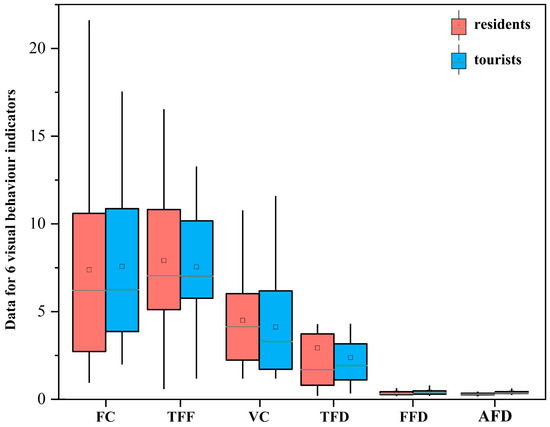
Figure 5.
Viewers’ visual behavior data for different landscape architecture elements.
The data in Table S1 show that the F-value (i.e., the Levene F-statistic) has a p-value > 0.05 for six variables, and these six eye-tracking data all show the same variance. In the two-tailed test, the p-value is also >0.05; combined with the F-statistic, this suggests that the visual behavior of the two groups toward the same landscape architecture elements has no significant difference, and the visual behavior characteristics of the same view are maintained.
4.2.2. Eye Movement Indicators of Different Visual Elements
A multivariate model with the proportion of visual elements as a covariate was used to analyze the influence of visual element types on visual behavior and to determine the differences. Again, we selected the eye-tracking experimental data for A-01, B-02, and C-02 as the data sources and used SPSS 21.0 (IBM Corp.) to conduct a one-way ANOVA for six eye movement indicators of seven visual elements in the landscape architecture image: landmark buildings, low-rise buildings, high-rise buildings, super high-rise buildings, water systems, mountains, and green plants. We then conducted a least significant difference multiple comparison test and obtained statistical data results (Figure 6, Supplementary Materials Table S2).
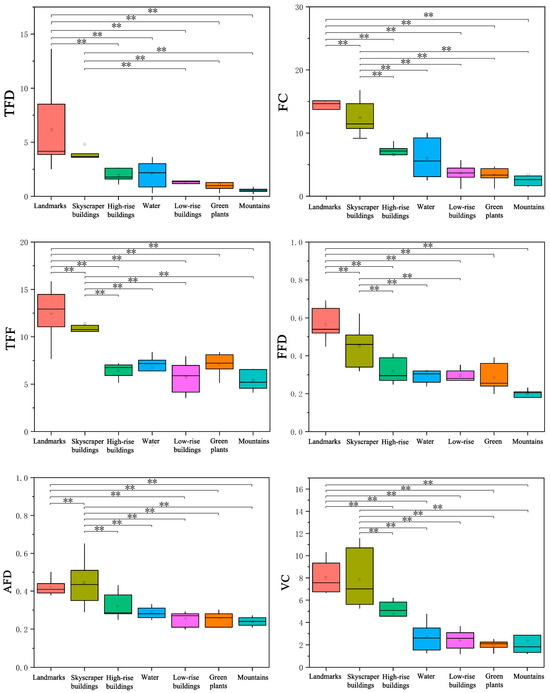
Figure 6.
Viewers’ visual behavior data for different landscape architecture elements (** Represents p < 0.01, which is significantly correlated at the 0.01 level).
From the data in Figure 6, after examining the eye movement indicators of visual elements in various landscape architecture images viewed from observation decks, it becomes evident that a significant difference exists for TFD and AFD at the 0.01 significance level (p < 0.01); the FC, FFD, and VC indicators display a significant difference at the 0.05 significance level (p < 0.05). However, no significant difference can be observed in TFF (p > 0.05).
Among the eye movement indicators for different visual elements, those of super high-rise buildings and landmark buildings showed the greatest significance. In terms of the AFD and FC eye movement indicators, the average values of the visual elements of super high-rise buildings and landmark buildings were relatively high. This implies that participants faced the most difficulty in extracting data from super high-rise and landmark buildings, as this demanded a larger cognitive load. Generally, the trends for the FFD, TFF, AFD, and VC eye movement indicators were largely in line with that of TFD. They also corresponded to the distribution outcomes of the eye movement heat map.
In summary, the eye-tracking indicators revealed differences in the TFD, FC, FFD, AFD, and VC data between the visual behavior indicators of the viewers when looking at urban landscape architecture (p < 0.05). Different groups of people have consistent perceptions of the same landscape, but their perceptions of different visual elements vary. Therefore, we can verify that H1 is valid.
4.3. Questionnaire Data Results and Analysis
4.3.1. Questionnaire Validity Test
The data from 237 questionnaires were imported into SPSS 21.0 for reliability and validity testing. The reliability of the four dimensions of the questionnaire was monitored, and a Cronbach’s value of >0.7 was found, indicating that the overall reliability of the questionnaire was good. A Kaiser–Meyer–Olkin (KMO) test revealed a KMO value = 0.978 > 0.8 and a p-value (Sig.) = 0.000 < 0.05, with high significance. The questionnaire passed the BART spherical test of the KMO checksum.
4.3.2. Psychological Measurement of Place Identity in Different Groups of Viewers
A total of 237 questionnaires were used as data sources to divide the participants into residents (n = 126) and tourists (n = 111), and an independent sample t-test compared the significance of the identity psychology between the two groups when visiting the same landscape architecture and place (Figure 7).
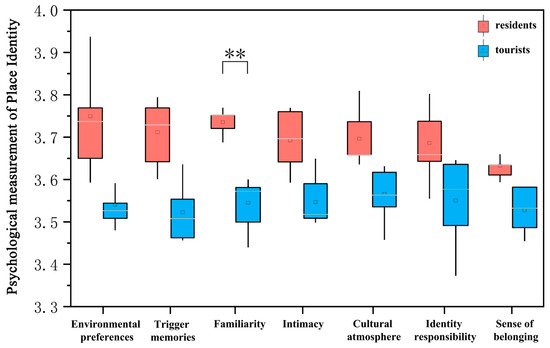
Figure 7.
Psychometric results for participants at the view scene (** Represents p < 0.01, which is significantly correlated at the 0.01 level).
The data in Figure 7 show that among the seven measurement indicators of place identity emotion for nine spots in the landscape architecture, the mean value of the resident group is greater than that of the tourist group. This indicates that the average value of residents’ place identity emotion relating to landscape architecture is higher than that of tourists. However, the independent samples t-test shows that the six place identity sentiment indicators have p-values > 0.05. That said, the familiarity index has a p-value of < 0.05, so there was a significant difference in the familiarity index in the place identity between residents and tourists in the process of viewing the same landscape, and there was no significant difference in other indicators. Although Hypothesis 2 is established, and residents have a higher sense of place identity than tourists, there is a significant difference only in the familiarity of place identity dimension.
4.3.3. Psychological Correlation with Place Identity
To verify the validity of H3, a two-variable Pearson correlation analysis was carried out between the aesthetic evaluation scores of the different visual elements of the landscape architecture seen from the observation decks and the psychological dimensions of place identity. Moreover, the aesthetic evaluation indexes and data for visual elements with a direct correlation with the psychology of place identity were screened out (Table 5).

Table 5.
Biased correlation analysis of aesthetic evaluation of visual elements and place identity.
From the results in Table 5, we can draw the following conclusions:
- (1)
- There were 10 visual aesthetic evaluation indexes with a 0.05 level of significance for place identity psychology and six visual evaluation factors with a 0.01 level of significance for place identity psychology.
- (2)
- From the perspective of visual element categories, the aesthetic perception of green plant visual elements had the strongest psychological correlation with place identity (0.754); the intimacy correlation coefficient between the color vividness of green plants and the psychological dimension of place identity was the highest (0.834); and the number of evaluation indicators with a correlation between water visual elements and place identity psychology was the highest. There is a significant positive correlation between natural visual elements and place identity.
- (3)
- Regarding the evaluation factor categories, the visual aesthetic evaluation index of decorative sophistication and the psychological correlation coefficient of place identity exhibited a negative relationship. Therefore, the visual aesthetic evaluation of decorative sophistication had a negative correlation with place identity psychology. The correlation coefficients between the other significance evaluation factors and place identity psychology were positive; therefore, the seven types of visual aesthetic evaluation indexes (e.g., proportion coordination, form richness, neatness, and color vividness) had a positive correlation with place identity psychology.
- (4)
- Among the 16 aesthetic evaluation indexes of visual elements that correlated with the psychology of place identity, the correlation coefficients of the color vividness of green plants and the color vividness of water were >0.7, indicating that there was a strong positive correlation between these two items. The correlation coefficients between the remaining 14 visual element aesthetic evaluation indexes and place identity psychology were within 0.3–0.7, indicating that these 14 aesthetic evaluation indicators strongly correlated with the psychological notion of identity.
4.3.4. Multiple Linear Regression Results and Analysis
Multiple linear regression was used to verify common visual elements affecting identity psychology in landscape architectures seen from different urban observation decks. The dependent variable was “city identity sense”, while the independent variables were the data of eight visual elements and fifty-six corresponding visual aesthetic evaluation indicators. Model summary, ANOVA results, and coefficient results (Table 6) were obtained, yielding the multiple regression equation.
Y = 0.573 × x1 + 0.316 × x2 + 0.515 × x3 + 0.169 × x4 + 0.617 × x5 + 0.223 × x6 + 0.799 × x7 + 0.094 × x8 + 1.021 × x9 − 3.10

Table 6.
Multiple linear regression model data table.
Based on the data from the overall regression model presented in the table, the following results can be derived.
- (1)
- F = 14.251 and p-value = 0.009 < 0.05, which is less than 0.05. This indicates that the model is significant at the 0.05 level. It passes the F-test and has a linear correlation with the dependent variable. Hence, the model is validated.
- (2)
- The adjusted R2 considers the number of predictors used to forecast the target variable, helping to decide if adding new variables improves the model fit. Here, the adjusted R2 value was 0.726. This implies that the nine influencing factors could account for 72.6% of the variation in identity psychology. In other words, 72.6% of the attachment emotion resulted from these nine factors, suggesting that the model had a moderate fit.
- (3)
- The Durbin–Watson (D–W) value = 2.006; since this value is close to 2, it implies that there is no autocorrelation present. As a result, the data used in the model are independent.
Based on the significance and correlation coefficients of the independent and dependent variables, the following conclusions can be reached.
- (1)
- Among the independent variables, the color brightness of green plants (p = 0.000 < 0.01, B = 1.021), the color vividness of mountains (p = 0.000 < 0.01, B = 0.799), the color vividness of water (p = 0.000 < 0.01, B = 0.617), the color vividness of landmarks (p = 0.000 < 0.01, B = 0.573), the color brightness of skyscraper buildings (p = 0.000 < 0.01, B = 0.515), the color brightness of high-rise buildings (p = 0.001 < 0.05, B = 0.316), the proportional coordination of mountains (p = 0.001 < 0.01, B = 0.223), and the morphological richness of green plants (p = 0.007 < 0.01, B = 0.094) were prominent. There was a significant positive correlation between the evaluation factors of these nine visual elements and identity psychology.
- (2)
- The correlation coefficient of the decorative delicacy evaluation is less than 0, but the p-value is more than 0.05, and the correlation coefficient is less than 0.3; therefore, although there is a negative correlation between decorative delicacy and the identity of place of each visual element, the influence is small. Overall, the multiple linear regression results are consistent with the correlation analysis, and Hypothesis 3 is verified.
5. Discussion
5.1. Visual Aesthetic Evaluation and Psychological Verification of Place Identity
Our results show that people’s visual perception of different landscape elements has significant differences; the aesthetic evaluation of landscape elements significantly influences the psychology of place identity; and the influence of natural landscape elements is higher than that of artificial landscape elements. In our analysis of the eye-tracking visual behavior data, the public showed a strong interest in and visual preference for artificial elements, particularly recognizable landmark buildings and skyscraper buildings, providing support for similar results obtained in research on visual preference behavior relating to mountain landscape architecture [30]. In previous studies, the perceptions of a landscape supporting autonomy, relatedness, and competence were associated with identification, dependence, and emotional connection with that landscape [31]. The proportion of artificial visual elements in the urban environment of the historic urban area is much higher than that of natural visual elements. However, the visual aesthetic perception of natural elements such as water, mountains, and green plants, has a more significant impact on the psychological perception of place identity, which is also supported by a study of visual perception among different groups of tourists [32]. Studies of visual perception in different populations have also shown that people experience a more positive psychological impact from natural landscape elements [33]. From visual behaviors to emotional cognition, viewers display great subjectivity in expressing different emotions. Combined with the experimental results of this study, this indicates that there are differences in people’s perceptual behaviors toward different visual elements of the landscape.
After previous studies showed that the most characteristic feature of the historic urban landscape of Macao is the diversity of colors, eye-tracking experiments and data collection were used to determine the most common colors in urban and landscape architecture in 60 districts of the city [34]. The results of that study also showed the significant influence of color vividness on the psychological impact of identification with different visual elements. Further research found that landmarks and super-tall buildings are more visually appealing to the public in urban landscape environments.
For the landscape of Macao’s historic district, although eye movement experiments found that different groups have significant visual behaviors toward visually attractive landmarks, the proportion of visual elements in the landscape images revealed that important landscapes in Macao’s historic district are affected by super high-rise buildings and that the proportion of landmarks in these images is relatively small, less than 1%. The lighthouse landmark can only be seen from a wide perspective, and the former outer harbor cannot be seen from the Guia Lighthouse. In 2008, the Macau government promulgated the first visual landscape control regulation after the Historic Centre of Macao was deemed a World Heritage Site, “Setting the Maximum Allowable Altitude for Buildings to be Constructed in the Area Around the Guia Lighthouse”. This set the height limit for buildings around the Guia Lighthouse at 60 m, which was relaxed to 90 m in 2015 for a particular planned building. However, UNESCO warned against this, and the developer cooperated with the government in reducing the height of this building [22]. In this study, our analysis of visual behavior and measurement of place identity provides data support for controlling building height within the important line of sight in the historic urban area.
5.2. Limitations and Future Work
This study reveals that residents and tourists do not have significant differences in their perceived behaviors regarding the same urban landscape. However, there are significant differences in people’s perceptions of different landscape elements, and the aesthetic perceptions of different landscape elements have a significant effect on place identity, providing a new perspective for enhancing the sense of identity of the city. That said, there are some limitations. To enhance the universality and representativeness of these findings, it is essential to significantly expand the number of subjects. This should involve recruiting participants from diverse cultural backgrounds, various social and economic classes, and different geographical regions [35].
Future work will need to explore the differences in participants’ affective attitudes related to their own identity features in the environment in more depth. Previous research has found that men and women differ in their overall and localized focus on the environment, with women being more concerned with the overall image and men being more interested in specific localized areas [36]. In addition to eye-tracking, physiological sensing devices, GPS location devices, and human behavior recognition are all useful methods for capturing behavioral data. These behavioral metrics data can be processed by artificial neural networks, and visual quality models can be built to support decision-making. Therefore, future research will require deep intersections with other disciplines to provide data to inform landscape architecture theory development and guide urban overlook planning and management.
6. Conclusions
Synthesizing the discussion of this research and previous studies, we aimed to investigate whether there are differences in the visual perception behaviors of different groups of people toward the same historic urban landscape and different landscape elements. By analyzing the experimental data, we determined that there was no significant difference in the visual behavior of residents and tourists viewing the same landscape images. However, in the analysis of the behavioral data for different visual elements in the landscape architecture, TFD, AFD, FC, FFD, and VC showed significant differences (p < 0.05). Eye movement behavior related to the visual elements of landmark buildings and super high-rise buildings was the most significant, indicating that H1 is valid.
This study also examines the variability of place identity sentiments toward different groups of people in the same landscape. The questionnaire data show that the average level of place identity for residents is higher than that of tourists, and there is a significant difference in familiarity indexes (p < 0.05), indicating that H2 holds true.
Regarding the influence of the aesthetic perception of different visual elements on place identity, we combined the results of the visual aesthetic evaluation and the psychological measurement of identity through correlation analysis and multiple linear regression analysis. We concluded that different landscape visual elements in Macao have correlations with place identity, such as the color brightness of green plants, the vividness of the color of mountains, the vividness of the color of water bodies, the vividness of the color of landmark buildings, the vividness of skyscrapers, the vividness of high-rise buildings, the proportionality and harmony of mountains, and the morphological richness of green plants. They also have a significant positive effect on place identity. Regarding the visual evaluation factors, the delicacy of decoration is negatively correlated with identity psychology. However, the effect is not significant, indicating that H3 holds.
This study is significant for improving viewers’ perceptions and evaluations of urban landscapes. Using an eye-tracking experiment, the visual elements of building facades and street styles that were the most important to the public were extracted. Combined with an evaluation of the visual elements, an aesthetic evaluation of landscape architecture viewed from various observation decks was performed. The ability of the visual landscape architecture to stimulate viewers’ sense of urban identity was explored using a place identity psychological scale, and the results can serve as a basis for urban landscape architecture planning and tourism management. In future research on the visual environment of architecture, eye-tracking experiments can be applied to virtual reality scenes to compare viewers’ evaluations of the visual environment of landscape architecture before and after a change.
Supplementary Materials
The following supporting information can be downloaded at: https://www.mdpi.com/article/10.3390/app15073875/s1, Table S1: Average of resident and visitor eye movement indicator data. Table S2: One-way ANOVA of eye movement indexes for different visual elements. Table S3: Coefficient of correlation between visual perception and place identity.
Author Contributions
Conceptualization, P.W. and H.F.; methodology, H.F.; software, H.F.; validation, H.F.; formal analysis, H.F.; investigation, H.F.; resources, H.F.; data curation, H.F.; writing—original draft preparation, H.F.; writing—review and editing, P.W.; visualization, H.F.; supervision, P.W.; project administration, P.W.; funding acquisition, P.W. All authors have read and agreed to the published version of the manuscript.
Funding
This research was funded by the Science and Technology Development Fund of the Macao Special Administrative Region, grant number 0036/2022/A, Philosophy and Social Science Planning Projects in Shanxi Province, grant number 2023YY103.
Institutional Review Board Statement
This study was conducted in accordance with the Declaration of Helsinki and approved by the Institutional Ethics Committee of the City University of Macau (protocol code 2024-RE-24, 10 April 2024).
Informed Consent Statement
Informed consent was obtained from all subjects involved in this study. Written informed consent was obtained from the participants to publish this paper.
Data Availability Statement
The original contributions presented in this study are included in the article/Supplementary Materials. Further inquiries can be directed to the corresponding author.
Conflicts of Interest
The authors declare no conflicts of interest.
References
- UNESCO World Heritage Convention. 44 COM 7B.141—Decision. Available online: https://whc.unesco.org/en/decisions/7856/ (accessed on 21 January 2025).
- Macaomagazine. City of the Future. 6 April 2022. Available online: https://macaomagazine.net/city-of-the-future/ (accessed on 26 May 2024).
- Liu, M.; Nijhuis, S. Mapping landscape spaces: Methods for understanding spatial-visual characteristics in landscape design. Environ. Impact Assess. Rev. 2020, 82, 106376. [Google Scholar] [CrossRef]
- Hadavi, S. Direct and Indirect Effects of the Physical Aspects of the Environment on Mental Well-Being. Environ. Behav. 2017, 49, 1071–1104. [Google Scholar] [CrossRef]
- Liu, Q.; Zhu, Z.; Zeng, X.; Zhuo, Z.; Ye, B.; Fang, L.; Huang, Q.; Lai, P. The impact of landscape complexity on preference ratings and eye fixation of various urban green space settings. Urban For. Urban Green. 2021, 66, 127411. [Google Scholar] [CrossRef]
- Gholami, Y.; Taghvaei, S.H.; Norouzian-Maleki, S.; Mansouri Sepehr, R. Identifying the stimulus of visual perception based on Eye-tracking in Urban Parks: Case Study of Mellat Park in Tehran. J. For. Res. 2021, 26, 91–100. [Google Scholar] [CrossRef]
- Fu, H.; Wang, P.; Zhou, J.; Zhang, S.; Li, Y. Investigating Influence of Visual Elements of Arcade Buildings and Streetscapes on Place Identity Using Eye-Tracking and Semantic Differential Methods. Buildings 2023, 13, 1580. [Google Scholar] [CrossRef]
- Scott, N.; Zhang, R.; Le, D.; Moyle, B. A review of eye-tracking research in tourism. Curr. Issues Tour. 2017, 22, 1244–1261. [Google Scholar] [CrossRef]
- Amati, M.; Ghanbari Parmehr, E.; McCarthy, C.; Sita, J. How eye-catching are natural features when walking through a park? Eye-tracking responses to videos of walks. Urban For. Urban Green. 2018, 31, 67–78. [Google Scholar] [CrossRef]
- Li, J.; Zhang, Z.; Jing, F.; Gao, J.; Ma, J.; Shao, G.; Noel, S. An evaluation of urban green space in Shanghai, China, using eye tracking. Urban For. Urban Green. 2020, 56, 126903. [Google Scholar] [CrossRef]
- Zhou, S.; Gao, Y.; Zhang, Z.; Zhang, W.; Meng, H.; Zhang, T. Visual Behaviour and Cognitive Preferences of Users for Constituent Elements in Forest Landscape Spaces. Forests 2022, 13, 47. [Google Scholar] [CrossRef]
- Guo, S.; Sun, W.; Chen, W.; Zhang, J.; Liu, P. Impact of Artificial Elements on Mountain Landscape Perception: An Eye-Tracking Study. Land 2021, 10, 1102. [Google Scholar] [CrossRef]
- Zhang, L.-M.; Zhang, R.-X.; Jeng, T.-S.; Zeng, Z.-Y. Cityscape Protection Using VR and Eye Tracking Technology. J. Vis. Commun. Image Represent. 2019, 64, 102639. [Google Scholar] [CrossRef]
- Simpson, J.; Freeth, M.; Simpson, K.J.; Thwaites, K. Visual Engagement with Urban Street Edges: Insights Using Mobile Eye-Tracking. J. Urban. Int. Res. Placemaking Urban Sustain. 2019, 12, 259–278. [Google Scholar] [CrossRef]
- Justulin Zacarias, E.F.; Gasparetto Higuchi, M.I. Overview of studies on place identity. Novos Cad. Naea 2021, 24, 57–72. [Google Scholar]
- Brian, F. Blake Topophilia: A Study of Environmental Perception, Attitudes and Values. By Yi-Fu Tuan. J. Leis. Res. 1974, 6, 323–325. [Google Scholar] [CrossRef]
- Kyle, G.T.; Jun, J.; Absher, J.D. Repositioning Identity in Conceptualizations of Human–Place Bonding. Environ. Behav. 2014, 46, 1018–1043. [Google Scholar] [CrossRef]
- Tenzer, M.; Schofield, J. People and places: Towards an understanding and categorisation of reasons for place attachment—Case studies from the north of England. Landsc. Res. 2023, 49, 340–358. [Google Scholar] [CrossRef]
- Lin, Z.; Chen, Y.; Filieri, R. Resident-tourist value co-creation: The role of residents’ perceived tourism impacts and life satisfaction. Tour. Manag. 2017, 61, 436–442. [Google Scholar] [CrossRef]
- Zhao, X.; Lu, Y.; Lin, G. An integrated deep learning approach for assessing the visual qualities of built environments utilizing street view images. Eng. Appl. Artif. Intell. 2024, 130, 107805. [Google Scholar] [CrossRef]
- Jiang, B.; Xu, W.; Ji, W.; Kim, G.; Pryor, M.; Sullivan, W.C. Impacts of nature and built acoustic-visual environments on human’s multidimensional mood states: A cross-continent experiment. J. Environ. Psychol. 2021, 77, 101659. [Google Scholar] [CrossRef]
- Government of Macao Special Administrative Region Statistics and Census Service. Statistics—Statistics and Census Service. Available online: https://www.dsec.gov.mo/en-US/Statistic?id=101 (accessed on 17 February 2024).
- Zhang, H.; Lai, P.Y.; Jim, C.Y. Species diversity and spatial pattern of old and precious trees in Macau. Landsc. Urban Plan. 2017, 162, 56–67. [Google Scholar] [CrossRef]
- Zheng, J. The Cultural Construction and Conservation Dilemma of Architectural Cultural Heritage in the Later World Heritage Era of Macao World Architecture; The Cultural Affairs Bureau of the Macao Special Administrative Region Government: Macao, China, 2019; Volume 11, pp. 44–49. Available online: https://www.culturalheritage.mo/Survey/sgchm2017/cn/?AspxAutoDetectCookieSupport=1 (accessed on 13 December 2024).
- Announcement of the Ministry of Housing and Urban-Rural Development on the Issuance of the National Standard “Unified Standard for Civil Building Design”. Available online: https://www.mohurd.gov.cn/gongkai/zc/wjk/art/2024/art_17339_240715.html (accessed on 9 January 2024).
- Gao, Y.; Sun, X.M.; Zhang, T.; Zhan, H. Analysis on the characteristics of eye movement and the evaluation of psychological perception for forest waterscape space. IOP Conf. Ser. Earth Environ. Sci. 2021, 626, 012007. [Google Scholar] [CrossRef]
- Van Loo, E.J.; Caputo, V.; Nayga, R.M.; Seo, H.-S.; Zhang, B.; Verbeke, W. Sustainability labels on coffee: Consumer preferences, willingness-to-pay and visual attention to attributes. Ecol. Econ. 2015, 118, 215–225. [Google Scholar] [CrossRef]
- Li, N.; Zhang, S.; Xia, L.; Wu, Y. Investigating the Visual Behavior Characteristics of Architectural Heritage Using Eye-Tracking. Buildings 2022, 12, 1058. [Google Scholar] [CrossRef]
- Boley, B.B.; Strzelecka, M.; Yeager, E.P.; Ribeiro, M.A.; Aleshinloye, K.D.; Woosnam, K.M.; Mimbs, B.P. Measuring place attachment with the Abbreviated Place Attachment Scale (APAS). J. Environ. Psychol. 2021, 74, 101577. [Google Scholar] [CrossRef]
- Li, Z.; Sun, X.; Zhao, S.; Zuo, H. Integrating eye-movement analysis and the semantic differential method to analyze the visual effect of a traditional commercial block in Hefei, China. Front. Archit. Res. 2021, 10, 317–331. [Google Scholar] [CrossRef]
- Landon, A.C.; Woosnam, K.M.; Kyle, G.T.; Keith, S.J. Psychological Needs Satisfaction and Attachment to Natural Landscapes. Environ. Behav. 2021, 53, 661–683. [Google Scholar] [CrossRef]
- Huang, J.; Liang, J.; Yang, M.; Li, Y. Visual Preference Analysis and Planning Responses Based on Street View Images: A Case Study of Gulangyu Island, China. Land 2022, 12, 129. [Google Scholar] [CrossRef]
- Deng, L.; Li, X.; Luo, H.; Fu, E.-K.; Ma, J.; Sun, L.-X.; Huang, Z.; Cai, S.-Z.; Jia, Y. Empirical study of landscape types, landscape elements and landscape components of the urban park promoting physiological and psychological restoration. Urban For. Urban Green. 2020, 48, 126488. [Google Scholar] [CrossRef]
- Wang, P.; Song, W.; Zhou, J.; Tan, Y.; Wang, H. AI-Based Environmental Color System in Achieving Sustainable Urban Development. Systems 2023, 11, 135. [Google Scholar] [CrossRef]
- Liu, W.; Hu, Z.; Fei, Y.; Chen, J.; Yu, C. Eye Tracking and Semantic Evaluation for Ceramic Teapot Product Modeling. Appl. Sci. 2025, 15, 46. [Google Scholar] [CrossRef]
- Wang, P.; Yang, W.; Wang, D.; He, Y. Insights into Public Visual Behaviors through Eye-Tracking Tests: A Study Based on National Park System Pilot Area Landscapes. Land 2021, 10, 497. [Google Scholar] [CrossRef]
Disclaimer/Publisher’s Note: The statements, opinions and data contained in all publications are solely those of the individual author(s) and contributor(s) and not of MDPI and/or the editor(s). MDPI and/or the editor(s) disclaim responsibility for any injury to people or property resulting from any ideas, methods, instructions or products referred to in the content. |
© 2025 by the authors. Licensee MDPI, Basel, Switzerland. This article is an open access article distributed under the terms and conditions of the Creative Commons Attribution (CC BY) license (https://creativecommons.org/licenses/by/4.0/).










